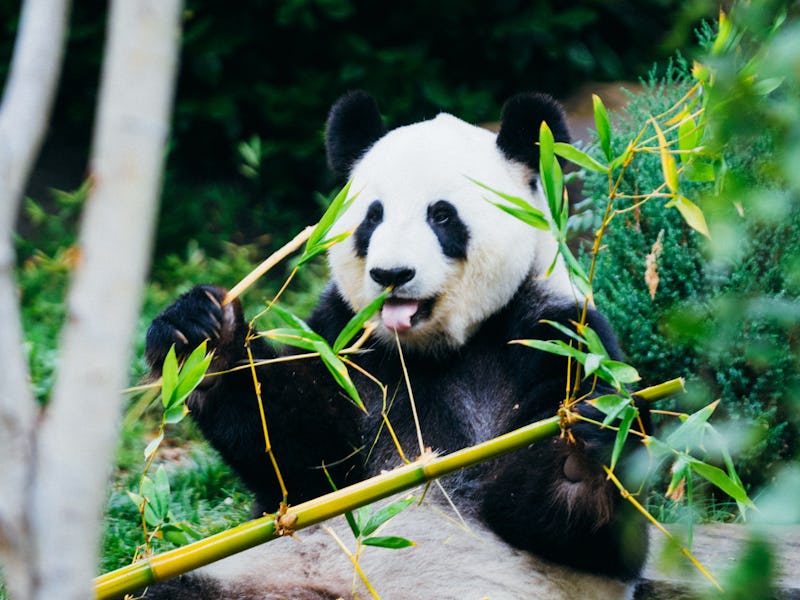For a Herbivore, the Giant Panda Sure Eats Like It's a Carnivore
Not what you'd expect from a bear that only eats bamboo.

If there’s anything that’s known for eating the same thing every day, it’s the giant panda. It only eats bamboo, making picky toddlers seem like gourmets in comparison. But despite its 24-hour bamboo diet, this large herbivore’s food consumption is still remarkably similar to that of its meat-eating relatives. New research in Current Biology suggests the nutrient content of the giant panda’s all-plant diet is so protein-rich that it’s basically a carnivore.
In a paper published Thursday, a team of scientists in China and Australia show that the giant panda’s highly specialized diet isn’t as strange for a bear as it might seem. Even though the giant panda’s teeth, jaw, paws, and metabolism are all well-adapted to eating plants, previous work has shown that its digestive system is more like that of a carnivore.
Complicating this mismatch, the authors of the new study demonstrate that a giant panda gets about 48 percent of its energy from protein, 39 percent from carbohydrates, and 13 from fat. This proportion isn’t that far off from the diets of hypercarnivores — animals that get at least 70 percent of their energy from protein.
Giant pandas migrate seasonally to find the bamboo that has the highest protein contents.
“As we know, the giant panda is a Carnivora species, yet extremely specialized on a plant food, the bamboo,” said. corresponding author Fuwen Wei, Ph.D., a professor of zoology at the Chinese Academy of Sciences. “Based on what they eat, they absolutely belong to the herbivores, but considering the macronutrient composition of the ingested and absorbed diets, they belong to the carnivores.”
Macronutrients describe the components of food that are present in large quantities: protein, carbohydrates, and fat. These are just three components of an animal’s diet — along with micronutrients like vitamins and minerals — but they tell scientists a lot about an animal’s habits and evolutionary history.
In this study, Wei’s team measured the macronutrients pandas consume by tracking what they eat throughout the year. For eight months out of each year, giant pandas in China usually eat the leaves of a lowland species of bamboo, focusing on the tender shoots when they become available. For the other four months of the year, about April to August, they moved to higher elevations to munch on the bamboo species that grows there, again focusing on the shoots when possible.
Giant pandas focus on leaves and young shoots that have more protein and less fiber, rather than stalks, which have more fiber and less protein.
This habit, the study’s authors write, shows the giant panda’s clear preference for leaves and shoots over the stalks of the bamboo plant. Not by coincidence, the parts of the bamboo plant that the pandas prefer has much lower fiber contents and much more protein.
This plant-based diet has its shortcomings, though. Mainly, it’s not very calorie-dense, which makes it so that pandas have to eat a whole lot of bamboo — sometimes over 80 pounds a day. In other herbivores, gut microbes can help break down plant material into usable energy. But as was mentioned earlier, pandas don’t have typical herbivore digestive tracts, so they can’t efficiently process bamboo like a cow processes grass. Instead, the researchers suspect, the panda’s gut helps it eat a ton of bamboo to make up for this shortcoming.
In conclusion, the giant panda is a land of contrasts.
“In giant pandas, a short, carnivorous gut facilitates rapid throughput, and the high abundance and easy accessibility of bamboo enable large amounts to be eaten, compensating for low digestive efficiency,” they write. “This rapid throughput system is incompatible with endogenous or microbial digestion of refractory carbohydrates, thus helping to explain the carnivore-like digestive enzymes and gut microbiota.”
In this way, the giant panda represents a unique mix of carnivore and herbivore traits, not fully one, and not fully the other.
Abstract: Giant pandas are unusual in belonging to a primarily carnivorous clade and yet being extremely specialized herbivores that feed almost exclusively on highly fibrous bamboo. Paradoxically, they appear inconsistently adapted to their plant diet, bearing a mix of herbivore and carnivore traits. Herbivore traits include a skull, jaw musculature, and dentition that are adapted for fibrous diets and a specialized ‘‘pseudo-thumb’’ used for handling bamboo. They have lost functional versions of the T1R1 gene codes for umami taste receptors, which are often associated with meat eating. They also have an herbivore-like subcellular distribution of the metabolic enzyme alanine: glyoxylate aminotransferase. But meanwhile, giant pandas have a digestive tract, digestive enzymes, and a gut microbiota composition that resemble those of carnivores and not of herbivores. We draw on recent developments in multi-dimensional niche theory to examine this apparent paradox. We show that the pandas’ diet clustered in a macronutrient space among carnivores and was distinct from that of herbivores. The similarity with carnivore diets applied not only to the ingested diet but also to the absorbed diet, with the absorbed macronutrient ratios similar to those of the ingested foods. Comparison of the macronutrient composition of pandas’ milk with those of other species shows that the carnivore-like dietary macronutrient composition extends across the life cycle. These results cast new light on the seemingly incongruous constellation of dietary adaptations in pandas, suggesting that the transition from carnivorous and omnivorous ancestry to specialized herbivory might be less abrupt than it might otherwise appear.